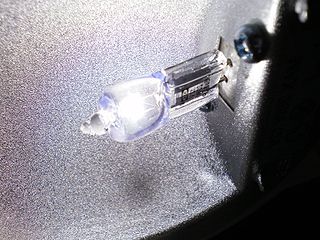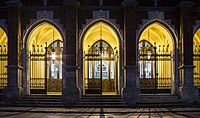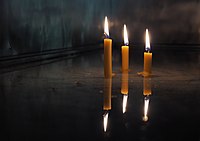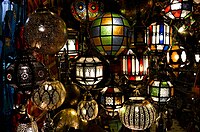
An electric light, lamp, or light bulb is an electrical component that produces light. It is the most common form of artificial lighting. Lamps usually have a base made of ceramic, metal, glass, or plastic, which secures the lamp in the socket of a light fixture, which is often called a "lamp" as well. The electrical connection to the socket may be made with a screw-thread base, two metal pins, two metal caps or a bayonet mount.

An incandescent light bulb, incandescent lamp or incandescent light globe is an electric light with a filament that is heated until it glows. The filament is enclosed in a glass bulb that is either evacuated or filled with inert gas to protect the filament from oxidation. Electric current is supplied to the filament by terminals or wires embedded in the glass. A bulb socket provides mechanical support and electrical connections.

A halogen lamp is an incandescent lamp consisting of a tungsten filament sealed in a compact transparent envelope that is filled with a mixture of an inert gas and a small amount of a halogen, such as iodine or bromine. The combination of the halogen gas and the tungsten filament produces a halogen-cycle chemical reaction, which redeposits evaporated tungsten on the filament, increasing its life and maintaining the clarity of the envelope. This allows the filament to operate at a higher temperature than a standard incandescent lamp of similar power and operating life; this also produces light with higher luminous efficacy and color temperature. The small size of halogen lamps permits their use in compact optical systems for projectors and illumination. The small glass envelope may be enclosed in a much larger outer glass bulb, which has a lower temperature, protects the inner bulb from contamination, and makes the bulb mechanically more similar to a conventional lamp.

Lighting or illumination is the deliberate use of light to achieve practical or aesthetic effects. Lighting includes the use of both artificial light sources like lamps and light fixtures, as well as natural illumination by capturing daylight. Daylighting is sometimes used as the main source of light during daytime in buildings. This can save energy in place of using artificial lighting, which represents a major component of energy consumption in buildings. Proper lighting can enhance task performance, improve the appearance of an area, or have positive psychological effects on occupants.

A flashlight (US) or electric torch (CE), usually shortened to torch, is a portable hand-held electric lamp. Formerly, the light source typically was a miniature incandescent light bulb, but these have been displaced by light-emitting diodes (LEDs) since the early 2000s. A typical flashlight consists of the light source mounted in a reflector, a transparent cover to protect the light source and reflector, a battery, and a switch, all enclosed in a case.

Photometry is a branch of science that deals with the measurement of light in terms of its perceived brightness to the human eye. It is concerned with quantifying the amount of light that is emitted, transmitted, or received by an object or a system.

In electrical wiring, a light switch is a switch most commonly used to operate electric lights, permanently connected equipment, or electrical outlets. Portable lamps such as table lamps may have a light switch mounted on the socket, base, or in-line with the cord. Manually operated on/off switches may be substituted by dimmer switches that allow controlling the brightness of lamps as well as turning them on or off, time-controlled switches, occupancy-sensing switches, and remotely controlled switches and dimmers. Light switches are also found in flashlights, vehicles, and other devices.

A compact fluorescent lamp (CFL), also called compact fluorescent light, energy-saving light and compact fluorescent tube, is a fluorescent lamp designed to replace an incandescent light bulb; some types fit into light fixtures designed for incandescent bulbs. The lamps use a tube that is curved or folded to fit into the space of an incandescent bulb, and a compact electronic ballast in the base of the lamp.

A mechanically powered flashlight is a flashlight that is powered by electricity generated by the muscle power of the user, so it does not need replacement of batteries, or recharging from an electrical source. There are several types which use different operating mechanisms. They use different motions to generate the required power; such as squeezing a handle, winding a crank, or shaking the flashlight itself. These flashlights can also be distinguished by the technique used to store the energy: a spring, a flywheel, a battery or a capacitor.

A lampshade is a fixture that envelops the lightbulb on a lamp to diffuse the light it emits. Lampshades can be made out of a large variety of materials like paper, glass, fabric or stone. Oftentimes conical or cylindrical in shape, lampshades can be found on floor, desk, tabletop, or suspended lamps. The term can also apply to the glass hung around many designs of ceiling lamp. Beyond its practical purpose, significant emphasis is also usually given to decorative and aesthetic features. A lamp shade also serves to "shade" human eyes from the direct glare of the light bulbs used to illuminate the lamp. Some lamp shades are also lined with a hard-backed opaque lining, often white or gold, to reflect as much light as possible through the top and bottom of the shade while blocking light from emitting through the walls of the shade itself. In other cases, the shade material is deliberately decorative so that upon illumination it may emphasize a display of color and light emitting through the shade surface itself.

A light fixture, light fitting, or luminaire is an electrical lighting device containing one or more light sources, such as lamps, and all the accessory components required for its operation to provide illumination to the environment. All light fixtures have a fixture body and one or more lamps. The lamps may be in sockets for easy replacement—or, in the case of some LED fixtures, hard-wired in place.

Edison screw (ES) is a standard lightbulb socket for electric light bulbs. It was developed by Thomas Edison (1847–1931), patented in 1881, and was licensed in 1909 under General Electric's Mazda trademark. The bulbs have right-hand threaded metal bases (caps) which screw into matching threaded sockets. For bulbs powered by AC current, the thread is generally connected to neutral and the contact on the bottom tip of the base is connected to the "live" phase.

A tealight is a candle in a thin metal or plastic cup so that the candle can liquefy completely while lit. They are typically small, circular, usually wider than their height, and inexpensive. Tealights derive their name from their use in teapot warmers, but are also used as food warmers in general, e.g. fondue.

An LED lamp or LED light is an electric light that produces light using light-emitting diodes (LEDs). LED lamps are significantly more energy-efficient than equivalent incandescent lamps and fluorescent lamps. The most efficient commercially available LED lamps have efficiencies exceeding 200 lumens per watt (lm/W) and convert more than half the input power into light. Commercial LED lamps have a lifespan several times longer than both incandescent and fluorescent lamps.

Various governments have passed legislation to phase out manufacturing or importation of incandescent light bulbs for general lighting in favor of more energy-efficient alternatives. The regulations are generally based on efficiency, rather than use of incandescent technology. However, it is not unlawful to continue to buy or sell existing bulbs, which are unregulated.

A Shabbat lamp is a special lamp that has movable parts to expose or block out its light so it can be turned "on" or "off" while its power physically remains on. This enables the lamp's light to be controlled by those Shabbat observant Jews who accept this use, to make a room dark or light during Shabbat without actually switching the electrical power on or off, an act prohibited by Orthodox Judaism on both Shabbat and the Jewish Holidays.

A headlamp, headlight, or head torch (UK) is a light source affixed to the head typically for outdoor activities at night or in dark conditions such as caving, orienteering, hiking, skiing, backpacking, camping, mountaineering or mountain biking. Headlamps may also be used in adventure races. Headlamps are often used by workers in underground mining, search and rescue, surgeons, and by other workers who need hands-free directed lighting.

Holiday lighting technology has been subject to considerable development and variation since the replacement of candles by electric lights. While originally used during the Christmas holidays as Christmas lights, modern electric light arrays have become popular around the world in many cultures and are used both during religious festivals and for other purposes unconnected to any festivities.
Electron-stimulated luminescence (ESL) is production of light by cathodoluminescence, i.e. by a beam of electrons made to hit a fluorescent phosphor surface. This is also the method used to produce light in a cathode ray tube (CRT). Experimental light bulbs that were made using this technology do not include magnetic or electrostatic means to deflect the electron beam.
Designing lighting for the elderly requires special consideration and care from architects and lighting designers. As people age, they experience neurodegeneration in the retina and in the suprachiasmatic nucleus (SCN). Less light reaches the back of the eyes because the pupils decrease in size as one ages, the lens inside one's eye becomes thicker, and the lens scatters more light, causing objects and colors to appear less vivid. These symptoms are particularly common with persons having alzheimer's disease. Older people also have reduced levels of retinal illuminance, such as having smaller pupils and less transparent crystalline lenses. Furthermore, as an individual ages, they begins to lose retinal neurons, which not only compromises the ability to see but also to register a robust daily pattern of light-dark that is needed to maintain biological rhythms. The 24-hour light-dark cycle is the most important external stimulus for regulating the timing of the circadian cycle.





















